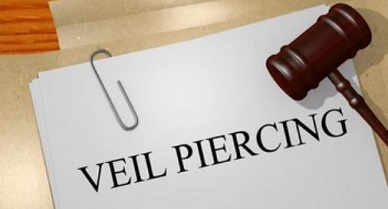Reverse Piercing of Corporate Veil
Introduction
The well-known principle which is often reiterated is that the liability of the corporation can be ascribed on to the shareholders as the corporation is merely a “artificial person” with a distinctive legal identity. Therefore, the doctrine of the limited liability of the company is firmly rooted in the English as well as Indian Jurisprudence. Whenever the limited liability is misused to shield illegal acts, the courts implement the “equity principle” to pierce the veil of the separate entity.
[Image Sources : Shutterstock]
There are several theories which govern the piercing of the corporate veil. According to Justice Cardzio, these different theories have diminishes the “status of metaphors”[i]. These theories include theory of agency, instrumentality, identity or alter ego and inequitable use of corporate form. These theories at times overlap in the principles and foundations. The lifting of the corporate veil is based on a two pronged test:
- There should be such an unity of the interest and ownership that the separate personalities of the corporation and the members do not arise.
- In case the impugned acts are treated as to have been done by the company alone, the result would be inequitable.[ii]
This test ensures that the foundation of the corporate law is not shaken at the whims and fancies of the litigants. The rule is also called “traditional corporate veil piercing theory”.
The Indian courts have also applied “complete administrative control” tests in order to allow the lifting of corporate veil in the cases where there is absolute control over management of a company.[iii]
Scope and Applicability in India
In case of India, the court applied the notion of alter ego in the case of Iridium India Telecom Limited v. Motorola Incorporation and Ors.[iv] Where it was observed that the criminal intent of the alter ego can be ascribed to the company. Then it was in the case Anita handa & Ors. V. God-father Travels[v] that the reverse piercing was applied by the Indian Couts. It was a case involving Section 141 of the NI Act, 1881 in which the criminal culpability of the individual was ascribed to the corporation.
The company law is silent about the doctrine of ‘reverse piercing’. However, several authors have defined it as a tool to make the assets of a corporation liable in cases of individual liability.
It can be seen that the doctrine is mostly being implemented in the case of Insolvency. However, there are several issues in its application. There is an ambiguity whether the creditors who have sought the reverse piercing be prioritised over the other rank holders under section 53 of the Insolvency and Bankruptcy Code. In the cases where the claims for the reverse piercing is allowed, there is involvement of an adjudicating authority and judicial mind so that the passing or denial of the resolution plan by the Committee of Creditors (CoC) is not a mere mechanical process. This infringes upon the supreme authority of Coc in the cases of passing of the resolution plans.
The provision of the reverse piercing is only applicable in the cases of individual insolvency and therefore it does not cover the corporate debtors.
Majority of the Indian courts are reluctant to allow the reverse piercing.[vi] The courts have held it to be outlandish and inconceivable.[vii]
Comparative Analysis
I. United States
US courts have been the pioneer in applying the doctrine of reverse piercing. The first case where the same was introduced was Alfred Booth v. Jeremiah Bunce[viii]. In this case there was a parent company which had transferred its fund to its subsidiary. The court applied the rule of alter ego in this case and allowed the reverse piercing. Thereafter, it was in the landmark case of FMC Finance Corp. v. Murphee that a three prong test was implemented to decide the applicability of the doctrine. The first element in this test was “degree of control” in which the court has to assess the extent of the control that the debtor has on the corporation. In order to satisfy this first condition, the control should be such that the acts of company and individual are subsumed. The second test is to assess whether there have been activities for ‘fraudulent or irregular purpose’ in the company. In case the existence of such acts is found, even if the acts are of an individual member, the condition would be satisfied. The third test is to assess if the alleged acts have caused any damage to the claimant. If all these three conditions are satisfied, the reverse piercing doctrine would be applicable.
II. Europe
Similar to Indian Courts, the European courts also have a rigid stance when it comes to the application of the Doctrine of Reverse Piercing. There have been numerous cases wherein these courts have referred to the lack of authority and precedents in order to hold that the reverse piercing does not find place in the English law. The protectionist attitude for the separate identity has led to a reluctance in invoking the doctrine of reverse piercing.
In the debated case of Macaura[ix], which has already been discussed in this project, the court denied the insurance money to the sole owner of the company merely to uphold the ground of separate legal entity.
Conclusion
Due to the increasing dynamism in the economic and corporate realities, the doctrine of reverse piercing cannot be disregarded merely to uphold the principle of separate legal entity. Just like the tradition piercing has been an exception to the doctrine of separate legal entity, the reverse piercing can be an exception to the traditional piercing.
Though the Indian courts have maintained their positivist attitude for quite a long time, the emerging jurisprudence in different legal systems make it prudent to them to incorporate this doctrine to meet the justice and have an equitable approach. It can not be denied that there are several caveats in implementing the reverse piercing as it not only impacts the creditor, debtor and the company, but also affects the innocent shareholders due to which the economic investment can be halted. However there are several tests which have been evolving and are being used by the foreign courts to balance the contradicting interests of the involved parties. In case these tests are implemented in a coherent structure in India, it can be suited to the challenges prevalent in the country and can also help to fill the legal vacuum in company law as well as insolvency law. Therefore it becomes the need of the hour that the doctrine of reverse piercing is incorporated.
Author: Kunal Yadav, a third-year law student at Rajiv Gandhi National University of Law, Punjab, in case of any queries please contact/write back to us at support@ipandlegalfilings.com or IP & Legal Filing.
REFRENCES
[i] Berkey v. Third Ave. Ry. Co., 244 N.Y. 84, 94.
[ii] Michael J. Gaertner, Reverse Piercing the Corporate Veil: Should Corporation Owners Have it Both Ways?, 30 William & Mary Law Review 14 (1989).
[iii] Balwant Rai Saluja v. Air India Ltd. & Ors., (2014) 9 SCC 407.
[iv] 2011 (1) (RCR) Criminal (235).
[v] 2012 (2) R.CR. (Criminal) 854.
[vi] Khurshid, ‘Reverse Piercing of Corporate Law: An unemployed phenomenon in India’
[vii] NEPC v SEBI, (2003) 3 Comp L.J 270 SAT.
[viii] 33 N.Y. 139 (N.Y. 1865)
[ix] Macaura v. Northern Assurance Company Ltd. and Others, [1925] AC 619.



